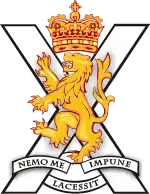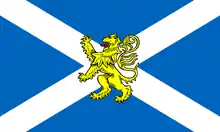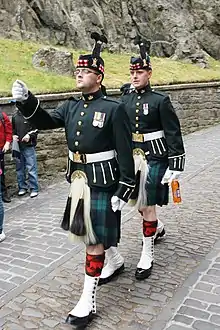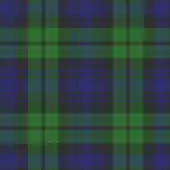Royal Regiment of Scotland
Le Royal Regiment of Scotland, littéralement le « Régiment royal d'Écosse », est le seul régiment écossais de l'infanterie de la British Army. Il comprend quatre bataillons et une compagnie incrémentale réguliers et deux bataillons de réserve. Ces bataillons sont d'anciens régiments distincts de la Division écossaise. Ainsi, le Royal Regiment of Scotland est devenu, avec The Rifles, le plus grand régiment d'infanterie de la British Army.
Ne doit pas être confondu avec Régiment Royal-Écossais ou The Royal Scots (The Royal Regiment).
| Royal Regiment of Scotland | ||
 Insigne du régiment. | ||
 La musique du Royal Regiment of Scotland. | ||
| Création | ||
|---|---|---|
| Dissolution | Toujours actif | |
| Pays | ||
| Allégeance | Monarque du Royaume-Uni | |
| Branche | British Army | |
| Type | Régiment | |
| Rôle | Infanterie | |
| Effectif | 3 200 | |
| Fait partie de | Division écossaise | |
| Garnison | Édimbourg (quartier général régimentaire) | |
| Devise | No One Provokes Me With Impunity (« Personne ne me provoque avec impunité ») | |
| Marche | Marche rapide : Scotland the Brave Marche lente : Royal Regiment of Scotland Slow March |
|
| Colonel en chef | Sa Majesté la reine Élisabeth II | |
| Colonel du régiment | Lieutenant-général Andrew Graham (en), CB CBE | |
Structure
Le Royal Regiment of Scotland fait partie de la Division écossaise. Il est composé de sept bataillons, quatre réguliers et deux de réserve en plus d'une compagnie incrémentale de carabiniers[1]. Tous les bataillons sont d'anciens régiments et ceux-ci ont gardé leurs identités régimentaires afin de conserver leurs liens régionaux.

| Nom | Brigade | Rôle | Garnison | |
|---|---|---|---|---|
| Bataillons réguliers | ||||
| The Royal Scots Borderers, 1st Battalion The Royal Regiment of Scotland (1 SCOTS)[2] | 38th (Irish) Brigade (en)[2] | Infanterie légère[2] | Casernes Palace (en) (Belfast)[2] | |
| The Royal Highland Fusiliers, 2nd Battalion The Royal Regiment of Scotland (2 SCOTS)[3] | 51st Infantry Brigade and Headquarters Scotland (en)[3] | Infanterie légère[3] | Casernes Glencorse (en) (Penicuik)[3] | |
| The Black Watch 3rd Battalion, The Royal Regiment of Scotland (3 SCOTS)[4] | 51st Infantry Brigade and Headquarters Scotland[4] | Mobilité protégée légère | Fort George[4] | |
| The Highlanders, 4th Battalion The Royal Regiment of Scotland (4 SCOTS)[5] | 20th Armoured Infantry Brigade (en) | Infanterie mécanisée | Garnison de Catterick (Catterick)[5] | |
| Balaklava Company (5 SCOTS)[6] | 51st Infantry Brigade and Headquarters Scotland[6] | Compagnie de carabiniers[6] | Casernes Redford (en) (Édimbourg)[6] | |
| Bataillons de réserve | ||||
| 52nd Lowland, 6th Battalion The Royal Regiment of Scotland (6 SCOTS)[7] | 51st Infantry Brigade and Headquarters Scotland | Infanterie légère | Glasgow | |
| 51st Highland, 7th Battalion The Royal Regiment of Scotland (7 SCOTS)[8] | 51st Infantry Brigade and Headquarters Scotland | Infanterie légère | Perth | |
Histoire
Création
Dans le cadre d'une restructuration de la British Army, la création du Royal Regiment of Scotland a été annoncée par le Secrétaire d'État à la Défense, Geoff Hoon, à la Chambre des communes le par la fusion de plusieurs régiments.
En fait, le régiment créé consiste en sept bataillons, l'un de ceux-ci étant formé par l'amalgamation de The Royal Scots (The Royal Regiment) et de The King's Own Scottish Borderers tandis que les autres sont directement formés par les régiments restants de la Division écossaise qui ne corportaient qu'un seul bataillon. Ainsi, The Royal Regiment of Scotland partage le titre du plus grand régiment d'infanterie de la British Army avec The Rifles.
En 2012, dans le cadre d'une réforme de la British Army, il a été annoncé que le 5e bataillon sera réduit au statut de compagnie incrémentale tout en conservant son nom et son histoire en tant que les Argyll and Sutherland Highlanders.
Lignée
Le Royal Regiment of Scotland a été formé par la réunion de six régiments en 2006 : The Royal Scots (The Royal Regiment), The Royal Highland Fusiliers (Princess Margaret's Own Glasgow and Ayrshire Regiment), The Royal Scots (The Royal Regiment), The Black Watch (Royal Highland Regiment), The Highlanders (Seaforth, Gordons and Camerons) et The Argyll and Sutherland Highlanders (Princess Louise's).
Insigne, drapeau et devise

L'insigne du Royal Regiment of Scotland a été dévoilé en août 2005 durant l'Edinburgh Military Tattoo. Il incorpore la croix de saint André et le lion rampant de l'étendard royal de l'Écosse, deux symboles importants de l'identité nationale écossaise. L'insigne est surmonté par la couronne de l'Écosse (en). En pointe, il y a un listel portant l'inscription « Nemo Me Impune Lacessit ». Il s'agit de la devise du régiment en latin qui signifie « Personne ne me provoque impunément ». Il s'agit également de la devise de l'Ordre du Chardon.
De son côté, le drapeau régimentaire reprend le drapeau de l'Écosse avec le lion rampant de l'étendard royal de l'Écosse en son centre.
Uniformes


Le tartan adopté par le Royal Regiment of Scotland est le « Government 1A » qui est parfois appelé « Sutherland ». Il s'agit du tartan qui était porté par The Argyll and Sutherland Highlanders (Princess Louise's).
En tenue de combat, chaque bataillon porte une plume (hackle en anglais) d'une couleur différente sur leur couvre-chef, le tam o' shanter :
- 1er bataillon : noir
- 2e bataillon : blanc
- 3e bataillon : rouge
- 4e bataillon : bleu
- 5e bataillon : vert
- 6e bataillon : gris
- 7e bataillon : violet
Colonel en chef

Le colonel en chef du régiment est Sa Majesté la reine Élisabeth II[9]. Les colonel-en-chefs des anciens régiments qui forment The Royal Regiment of Scotland sont devenus des « colonels royaux » (Royal Colonels en anglais) de leurs bataillons respectif :
- 1er bataillon : Son Altesse Royale la princesse royale Anne
- 2e bataillon : Son Altesse Royale le duc d'York Andrew
- 3e bataillon : Son Altesse Royale le duc de Rothesay Charles
- 4e bataillon : Son Altesse Royale le duc d'Édimbourg Philip
- 5e bataillon : Sa Majesté la reine Élisabeth II
- 6e bataillon : Son Altesse Royale la princesse royale Anne
- 7e bataillon : Son Altesse Royale le duc de Rothesay Charles
Notes et références
- (en) Cet article est partiellement ou en totalité issu de l’article de Wikipédia en anglais intitulé « Royal Regiment of Ssotland » (voir la liste des auteurs).
- (en) « The Royal Regiment of Scotland », sur British Army (consulté le )
- (en) « The Royal Scots Borderes (1 SCOTS) », sur British Army (consulté le )
- (en) « The Royal Highland Fusiliers (2 SCOTS) », sur British Army (consulté le )
- (en) « The Black Watch (3 SCOTS) », sur British Army (consulté le )
- (en) « The Highlanders (4 SCOTS) », sur British Army (consulté le )
- (en) « Balaklava Company (5 SCOTS) », sur British Army (consulté le )
- (en) « 52nd Lowland Battalion (6 SCOTS) », sur British Army (consulté le )
- « 51st Highland Battalion (7 SCOTS) », sur British Army (consulté le )
- (en) « About Us », sur British Army (consulté le )
Annexes
Articles connexes
Lien externe
- (en) The Royal Regiment of Scotland sur le site de la British Army
- Portail de l’Écosse
- Portail de l’histoire militaire